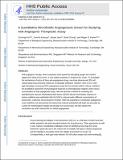| dc.contributor.author | Kim, Choong | |
| dc.contributor.author | Kasuya, Junichi | |
| dc.contributor.author | Jeon, Jessie S | |
| dc.contributor.author | Chung, Seok | |
| dc.contributor.author | Kamm, Roger Dale | |
| dc.date.accessioned | 2017-03-13T18:28:28Z | |
| dc.date.available | 2017-03-13T18:28:28Z | |
| dc.date.issued | 2014-11 | |
| dc.date.submitted | 2014-07 | |
| dc.identifier.issn | 1473-0197 | |
| dc.identifier.issn | 1473-0189 | |
| dc.identifier.uri | http://hdl.handle.net/1721.1/107403 | |
| dc.description.abstract | Anti-angiogenic therapy, which suppresses tumor growth by disrupting oxygen and nutrient supply from blood to the tumor, is now widely accepted as a treatment for cancer. To investigate the mechanisms of action of these anti-angiogenesis drugs, new three dimensional (3D) cell culture-based drug screening models are increasingly employed. However, there is no in vitro high-throughput screening (HTS) angiogenesis assay that can provide uniform culture conditions for the quantitative assessment of physiological responses to chemoattractant reagents under various concentrations of anti-angiogenesis drugs. Here we describe a method for screening and quantifying the vascular endothelial growth factor (VEGF)-induced chemotactic response on human umbilical vein endothelial cells (HUVECs) cultured with different concentrations of bortezomib, a selective 26S proteasome inhibitor. With this quantitative microfluidic angiogenesis screen (QMAS), we demonstrate that bortezomib-induced endothelial cell death is preceded by a series of morphological changes that develop over several days. We also explore the mechanisms by which bortezomib can inhibit angiogenesis. | en_US |
| dc.description.sponsorship | National Institutes of Health (U.S.) (R33 CA174550) | en_US |
| dc.description.sponsorship | National Science Foundation (U.S.) (CBET-0939511) | en_US |
| dc.description.sponsorship | National Research Foundation of Korea (Pioneer Research Center Program 2012-0009565 and 2014M3A7B4052193) | en_US |
| dc.description.sponsorship | Korea (South). Sanggong Chawŏnbu (No. 2012401020325) | en_US |
| dc.language.iso | en_US | |
| dc.publisher | Royal Society of Chemistry (Great Britain) | en_US |
| dc.relation.isversionof | http://dx.doi.org/10.1039/c4lc00866a | en_US |
| dc.rights | Creative Commons Attribution-Noncommercial-Share Alike | en_US |
| dc.rights.uri | http://creativecommons.org/licenses/by-nc-sa/4.0/ | en_US |
| dc.source | PMC | en_US |
| dc.title | A quantitative microfluidic angiogenesis screen for studying anti-angiogenic therapeutic drugs | en_US |
| dc.type | Article | en_US |
| dc.identifier.citation | Kim, Choong, Junichi Kasuya, Jessie Jeon, Seok Chung, and Roger D. Kamm. “A Quantitative Microfluidic Angiogenesis Screen for Studying Anti-Angiogenic Therapeutic Drugs.” Lab Chip 15, no. 1 (2015): 301–310. doi:10.1039/c4lc00866a. | en_US |
| dc.contributor.department | Massachusetts Institute of Technology. Department of Biological Engineering | |
| dc.contributor.department | Massachusetts Institute of Technology. Department of Mechanical Engineering | |
| dc.contributor.department | Singapore-MIT Alliance in Research and Technology (SMART) | |
| dc.contributor.mitauthor | Kasuya, Junichi | |
| dc.contributor.mitauthor | Jeon, Jessie S | |
| dc.contributor.mitauthor | Chung, Seok | |
| dc.contributor.mitauthor | Kamm, Roger Dale | |
| dc.relation.journal | Lab Chip | en_US |
| dc.eprint.version | Author's final manuscript | en_US |
| dc.type.uri | http://purl.org/eprint/type/JournalArticle | en_US |
| eprint.status | http://purl.org/eprint/status/PeerReviewed | en_US |
| dspace.orderedauthors | Kim, Choong; Kasuya, Junichi; Jeon, Jessie; Chung, Seok; Kamm, Roger D. | en_US |
| dspace.embargo.terms | N | en_US |
| dc.identifier.orcid | https://orcid.org/0000-0002-7232-304X | |
| mit.license | OPEN_ACCESS_POLICY | en_US |
| mit.metadata.status | Complete | |
